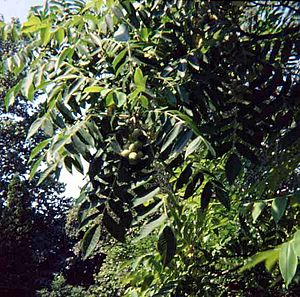Japanese walnut facts for kids
Quick facts for kids Japanese walnut |
|
|---|---|
 |
|
| Foliage and nuts | |
| Scientific classification | |
| Genus: |
Juglans
|
| Species: |
ailantifolia
|
The Japanese walnut (scientific name: Juglans ailantifolia) is a type of walnut tree. It comes from Japan and Sakhalin island. This tree is also known by its Japanese name, oni-gurumi, which means "demon walnut."
This tree loses its leaves in the fall, just like many other trees. It can grow up to 20 meters (about 65 feet) tall, and sometimes even 30 meters (nearly 100 feet). Its trunk can be 40 to 80 centimeters (16 to 31 inches) wide. The bark is usually light grey.
Japanese walnut leaves are quite large, about 50 to 90 centimeters (20 to 35 inches) long. Each leaf has 11 to 17 smaller leaflets. These leaflets are 7 to 16 centimeters (3 to 6 inches) long and 3 to 5 centimeters (1 to 2 inches) wide. The whole leaf feels soft and fuzzy, and it's a brighter, more yellowish-green than many other tree leaves.
In spring, when new leaves appear, the tree also grows flowers. The male flowers look like yellow-green catkins, which are long, hanging clusters. The female flowers have pretty pink or red parts. The tree's fruit is a nut, which grows in bunches of 4 to 10. Each nut is round, about 3 to 5 centimeters (1 to 2 inches) long and wide. Before they are ready in mid-autumn, the nuts are covered by a green husk.
Contents
What the Japanese Walnut is Used For
The nuts from the Japanese walnut are good to eat. They have a rich, oily taste. People also use the husks of the nuts to make a yellowish dye.
Because of its large, attractive leaves and pretty spring catkins, the Japanese walnut is a great ornamental tree. This means it's often planted in parks and big gardens to make them look nice.
The Japanese walnut is special because it can fight off a serious canker disease. This disease is caused by a fungus called Sirococcus clavigignenti-juglandacearum. This fungus is a big problem for the North American butternut tree, which is a close relative.
Because of this resistance, Japanese walnuts are often planted in North America. They help replace butternuts that have been lost to the disease. Japanese walnuts and butternuts can also easily mix together. When they do, they create a new tree called Juglans x bixbyi, or 'buartnut'. This hybrid tree is also resistant to the canker disease.
You can tell the Japanese walnut apart from the butternut by its bigger leaves and round nuts. Butternut nuts are more oval. Some people are even trying to cross buartnuts back with native butternuts. This creates 'butterbuarts', which look more like butternuts but might be more likely to get the canker disease.
The wood of the Japanese walnut is light in color and can be polished well. However, it's not as strong or valuable as the wood from the Persian walnut. It is often used to make furniture.
Special Types: Heartnut
The heartnut is a special type, or cultivar, of Japanese walnut. It's known for its unique fruit. The nut itself is shaped like a heart when you cut it in half. It's also very hard to crack, but when you do, the nut meat often comes out in one whole piece.
Heartnuts are sweet and don't have the bitter taste that some other walnuts, like black or Persian walnuts, can have. This is the type of Japanese walnut that mixes with butternuts to create 'buartnuts'.
The Toyo Tire company even found that the heartnut's shell is very hard and its broken pieces are sharp. Because of this, they used it as a material for snow tires, also known as studless tires.
Diseases Affecting the Japanese Walnut
Japanese walnuts are quite strong against diseases. The only major disease they can get is called Walnut Bunch Disease.
See also
 In Spanish: Nogal japonés para niños
In Spanish: Nogal japonés para niños



